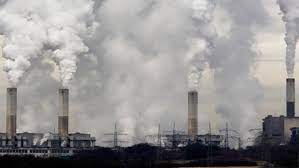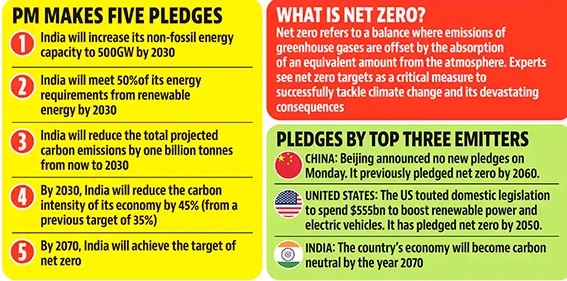CURRENT AFFAIRS
Get the most updated and recent current affair content on Padhaikaro.com
India Baulks at Carbon Neutral Target as Pressure Grows: Report
- IAS NEXT, Lucknow
- 23, Nov 2021

Developed countries have an extremely poor track record on climate action. In keeping with this trend, the recently declared enhanced pledges for climate action, including declarations of net-zero emissions by 2050, also fall woefully short of what is required to ensure the safety of the planet. The pressure on developing countries to “do more” and declare similar net-zero pledges is, therefore, nothing but shifting the burden of climate action onto the backs of the world’s poorest populations.
Moreover, India has announced that it will reach carbon neutrality by 2070 as part of a five-point action plan that included reducing emissions to 50% by 2030. There is a need to analyse the decision in the interest of development needs of India.
Energy For Development
- There is a strong link between energy use and development. No country has managed to ensure reasonable levels of wellbeing for its people without increasing energy supply.
- This would not be a problem if India could produce energy in abundance without carbon-dioxide emissions.
- Unfortunately, energy sources that are available, which can then be directed for specific purposes such as industrial production or transportation, often have other effects, most notably the emission of carbon dioxide, the greenhouse gas most responsible for global warming.
- From 1850 till 2019, the world has emitted approximately 2,500 billion tonnes of carbon dioxide. Developed countries, home to 18% of the global population, are responsible for over 60% of these emissions.
- Their unconstrained use of fossil fuel resources has allowed these countries to modernise their economies and achieve much higher levels of well-being than the remaining 82% of the population that resides in the Global South.
- The United Nations Framework Convention on Climate Change (UNFCCC) articulates the principle of differentiation between rich and poor nations and the need for the former to take lead in addressing the problem of global warming.
- However, almost three decades since the UNFCCC, the story of climate action has been one of utter inaction by the world’s richest countries, who have repeatedly shifted targets for emissions reductions and also for climate finance to the future.
- The recent focus on net-zero declarations and the pressure on all countries to submit pledges for the same, is yet another attempt in the same direction.
Net Zero Emission
- Net-zero emissions refer to the balancing of anthropogenic carbon dioxide emissions, either globally or in a region, with anthropogenic removals of the GHG so that the net effect is zero emissions.
- The push for such declarations from all countries began around 2019 at COP-25, when there was one year left for the Paris Agreement to come into effect.
- The very idea of net-zero declarations by individual countries and regions emerged from the need to hide the inaction of developed countries for the past 30 years.
- Even these declarations for the future are far from adequate to ensure the safety of the planet. The “enhanced pledges” of the US, UK and EU (27) for 2030, and their currently declared intention of achieving net-zero emissions around 2050, imply that just these two major regions will consume over 30% of even the remaining carbon budget.
- Together with China, they will emit at least 20% more carbon dioxide than is available to the world to limit warming to below 1.5 degrees Celsius.
Way Forward
- Development For All: The world needs much more ambition from rich countries (developed countries) so that less developed countries get some room to develop.
- The world needs to eliminate the multiple forms of drudgery and deprivation that a large majority of our people are subjected to.
- This requires ensuring access to modern, affordable, and reliable amenities and services to all. It is also critical to prepare for a world that is quite likely to be more than 1.5 degrees Celsius warmer. Our first defence against the climatic impacts in such a world will be development.
- Strengthening Climate Governance: India needs to build and strengthen its domestic institutions for climate governance. This will require identifying linkages between development needs and low carbon opportunities. In this context, a climate law can be useful.
- Reaffirming CBDR: In this upcoming climate change negotiations, India needs to reaffirm the long-standing principle of common but differentiated "common but differentiated responsibility" (CBDR) that requires richer countries to lead and argue against any pledge that risks prematurely limiting Indian energy use for development.
- Increase Renewable Capacity: According to the Council on Energy, Environment and Waters implications of a Net-zero Target for India’s Sectoral Energy Transitions and Climate Policy’ study, India’s total installed solar power capacity would need to increase to over 5,600 gigawatts to achieve net-zero by 2070.
- The usage of coal, especially for power generation, would need to drop by 99% by 2060, for India to achieve net-zero by 2070.
- Consumption of crude oil, across sectors, would need to peak by 2050 and fall substantially by 90% between 2050 and 2070.
- Green Hydrogen could contribute 19% of the total energy needs of the industrial sector.
- India’s energy future must be determined by the developmental needs of its people and their protection against the impacts of climate change.
- India’s efforts in the energy sector are evidence that it is punching far above its weight where climate action is concerned.
- While India does its fair share to check global warming, this should not be a blank cheque to developed countries to free ride on its efforts.
- It is essential that the fair share of India’s carbon space and consequently the energy future of its people be secured now.
Conclusion
- In accordance with the best available science as compiled by the most recent report of the Intergovernmental Panel on Climate Change, the countries who pledged for Net-Zero Emission must be asked to declare how much of the remaining carbon budget they plan to consume before they reach net-zero.
- The answer to this question is critical in determining where the world is headed. In this global context, our energy path for the future must be carefully charted, allowing flexibility, while keeping the interests of our poorest and most vulnerable populations at the centre of any pledges we make.
